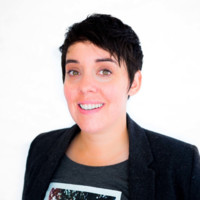 Andrea Belk Olson
Andrea Belk Olson The biggest risk to your business is what you actually see coming
We’re in flood season here in the Midwest. Waters are rising, but it’s not like in the movies, where a torrential flood sweeps across the landscape in seconds, and people are running for their lives. It’s actually quite uneventful. Temporary barriers get put up in streets over the course of multiple days. Water starts to be visible in grassy areas closest to the river, like a series of little splash pools. But within a couple of weeks, standing water will be 10 feet high or more behind those barriers, covering multiple city blocks. In fact, our town saw a breach in those barriers, which caused the water to inundate 12 city blocks, businesses, residences, and people had to be rescued by boat.
Floods are typically predictable. There are forecasts which discuss river levels, and projections for where the water will rise to and over what period of time. No one dismisses these projections, and we always prepare accordingly. But these floods don’t happen because there’s monsoon-level rain in the area. It happens because of extensive snow hundreds of miles north of us. The snowpack depth and melting rate where the Mississippi River begins determines our level and timing of flood risk.
While most companies don’t have this type of clear correlation or prediction capability to determine what will impact their organization, each and every company has its own proverbial ‘flood risk’. While we often view risks in the form of technology, competition, talent, or products, the trickiest risk is that which moves slowly over a long period of time. One that you don’t notice until the ‘water has breached the wall’ and even then, it still just seems like a puddle that you don’t have to really worry about.
This type of risk is the most overlooked and usually is the result of companies having an overly tight vision of the world around them. They look at their past success, often tied to a specific business model and organizational structure, and say, “This works. let’s keep doing it.” They don’t think about the snowpack in Minnesota – that’s too far away. It won’t impact us. Because they don’t think about it, they don’t change or prepare for the ‘flood’ – i.e., examine what’s changing in the customer landscape including new ways of communicating, engaging, and serving, and act on it – but rather continue down the same path.
The flood waters start to rise. They see ponding and high river levels – i.e. customer attrition and challenges in securing talent – but they believe this will pass. After all, it doesn’t flood every time the river levels get high. Then the water starts to get higher. It starts to cover the street. Still, the belief is the water will recede naturally, and it won’t reach the building. Then the roads become impassable. Water is coming into the ground floor and beginning to damage property. Sandbagging begins – i.e. scrambling to make organizational changes and reducing headcount – but it’s now too late. It’s either hope and pray for the waters to go down or get the lifeboats out.
The point of this story is that the real threats to businesses are those that move slowly. They come from areas so far afield from your own business and industry that you don’t consider them to be threats. You just move along day-to-day like everything’s fine. Not until it’s at your doorstep do you decide to act. Consider what your own ‘flood risk’ is, and whether you are actively working to mitigate that risk. More often than not, you’re watching the flood waters rise and you don’t even know it.
About the Author
Andrea Belk Olson is a keynote speaker, author, differentiation strategist, behavioral scientist, and customer-centricity expert. As the CEO of Pragmadik, she helps organizations of all sizes, from small businesses to Fortune 500, and has served as an outside consultant for EY and McKinsey. Andrea is the author of three books, including her most recent, What To Ask: How To Learn What Customers Need but Don’t Tell You, released in June 2022.
She is a 4-time ADDY® award winner and host of the popular Customer Mission podcast. Her thoughts have been continually featured in news sources such as Chief Executive Magazine, Entrepreneur Magazine, Harvard Business Review, Rotman Magazine, World Economic Forum, and more. Andrea is a sought-after speaker at conferences and corporate events throughout the world. She is a visiting lecturer and startup coach at the University of Iowa, a TEDx presenter, and TEDx speaker coach. She is also an instructor at the University of Iowa Venture School.
More information is also available on www.pragmadik.com and www.andreabelkolson.com.









